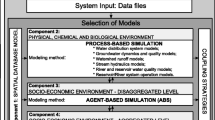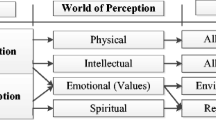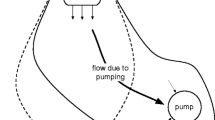Abstract
This paper discusses the development of an analytical support system for implementation of the Integrated Water Resources Management (IWRM) process. The system integrates four analytical tools: (i) geographic information system; (ii) system dynamics simulation; (iii) agent-based model; and (iv) hydrologic simulation. The choice of tools is driven by their ability to (a) respond to the main requirements of the IWRM and (b) explicitly describe system behaviour as function of time and location in space. The system dynamics simulation captures temporal dynamics in an integrated feedback model that includes sectors representing physical and socioeconomic system components. Management policies established in the participatory decision making environment are easily investigated through the simulation of system behaviour. Agent-based model is used to analyze spatial dynamics of complex physical-social-economic-biologic system. The IWRM support system is tested using data from the Upper Thames River Watershed, Ontario, Canada, in collaboration with the Upper Thames River Conservation Authority.









Similar content being viewed by others
References
Ahmad S (2002) An Intelligent decision support system for flood management: a spatial system dynamics approach. Dissertation, The University of Western Ontario, London, Canada
Ahmad S, Simonovic SP (2000a) Analysis of economic and social impacts of flood management policies using system dynamics. Proc. Int. Conf. of the American Institute of Hydrology. Atmospheric, Surface and Subsurface Hydrology and Interactions, Research Triangle Park, N.C.
Ahmad S, Simonovic SP (2000b) Dynamic modeling of flood management policies. Proc. 18th Int. Conf. of the System Dynamics Society, Sustainability in the Third Millennium, Bergen, Norway
Ahmad S, Simonovic SP (2000c) System dynamics modeling of reservoir operation for flood management. J Comput Civ Eng 14(3):190–198
Clavel L, Charron MH, Therond O, Leenhardt D (2012) A modelling solution for developing and evaluating agricultural land-use scenarios in water scarcity contexts. Water Resour Manag 26(9):2625–2641. doi:10.1007/s11269-012-0037-x
Coelho AC, Labadie JW, Fontane DG (2012) Multicriteria decision support system for regionalization of integrated water resources management. Water Resour Manag 26(5):1325–1346. doi:10.1007/s11269-011-9961-4
Cunderlik J, Simonovic SP (2004) Selection of Calibration and Verification Data for the HEC-HMS Hydrologic Model. Water Resources Research Report no. 047, Facility for Intelligent Decision Support, Department of Civil and Environmental Engineering, The University of Western Ontario, London, Ontario, Canada
Cunderlik J, Simonovic SP (2005) Hydrologic extremes in South–Western Ontario under future climate projections. J Hydrolog Sci 50(4):631–654
Cunderlik J, Simonovic SP (2007) Inverse flood risk modeling under changing climatic conditions. Hydrolog Sci J 21(5):563–577
Ferber J (1999) Multi-agent system: an introduction to distributed artificial intelligence. Addison-Wesley, Harlow
Feuillette S, Bousquet F, Le Goulven P (2003) (2003) SINUSE: a multi-agent model to negotiate water demand management on a free access water table. Environ Model Softw 18:413–427
Fletcher EJ (1998) The use of system dynamics as a decision support tool for the management of surface water resources. Proc. 1st Int. Conf. on New Information Technologies for Decision Making in Civil Engineering, Montreal, 909–920
Forrester JW (1961) Industrial dynamics. Pegasus Communications Inc., Willinston
Gunkel A (2005) The application of multi-agent systems for water resources research – possibilities and limits. Master Thesis, Institut für Hydrologie der Albert-Ludwigs-Universität Freiburg, Freiburg
Gunkel A, Kulls C (2005) Toward agent-based modelling of stakeholder behaviour – a pilot study of drought vulnerability of decentralized water supply in NE Brazil. International Environmental Modelling and Software Society (iEMSs)
Keyes AM, Palmer R (1993) The role of object oriented simulation models in the drought preparedness studies. Proc. Water Management in 90’s: a time for innovation, ASCE, New York
Lansing JS, Kremer JN (1993) Emergent properties of Balinese water temples. Am Anthropol 95(1):97–114
Mainuddin M, Kirby M, Qureshi ME (2007) Integrated hydrologic–economic modelling for analyzing water acquisition strategies in the Murray River Basin. Agr Water Manag 93:123–135
North MJ, Macal CM (2009) Agent-based modeling and systems dynamics model replication. International Journal of Simulation and Process Modelling
Ota S (2009) IWRM guidelines at river basin level, UNESCO
Prodanovic P, Simonovic SP (2007a) Impacts of changing climatic conditions in the upper Thames river basin. Canadian Water Resour Manag 32(4):265–284
Prodanovic P, Simonovic SP (2007a) integrated water resources modelling of the upper Thames river basin. Proceedings of the 18th CSCE Canadian Hydrotechnical Conference, Canadian Society for Civil engineering; 22–24 August, 2007; Winnipeg, Manitoba, Canada
Prodanovic P, Simonovic SP (2010) An operational model for integrated water resources management of a watershed. Int J Water Resour Manag 24(6):1161–1194
Raymond JK, Loucks DP, Stedinger JR, 10 (2012) Artificial neural network models of watershed nutrient loading. Water Resour Manag 26:2781–2797. doi:10.1007/s11269-012-0045-x
Simonovic SP (2009) Managing water resources: methods and tools for a systems approach, UNESCO, Paris and Earthscan James & James, London, pp. 576, ISBN 978-1-84407-554-6
Simonovic SP, Li L (2003) Methodology for assessment of climate change impacts on large-scale flood protection system. J Water Resour Plan Manag 129(5):361–371
Sterman JD (2000) Business dynamics: systems thinking and modeling for a complex world. McGraw-Hill, New York
Upper Thames River Conservation Authority UTRCA (2006) http://www.thamesriver.on.ca/ (accessed 09/2011)
USACE (2000) Hydrologic modelling system HEC–HMS, Technical reference manual. United States Army Corps of Engineers, Davis
Ward FA, Booker JF, Michelsen AM (2006) Integrated economic, hydrologic, and institutional analysis of policy responses to mitigate drought impacts in Rio Grande Basin. J Water Resour Plann Manag 132(6):488–502
Wilensky U (1999) NetLogo. http://ccl.northwestern.edu/netlogo/. Center for Connected Learning and Computer-Based Modeling, Northwestern University, Evanston, IL
Wooldridge M (2009) An introduction to MultiAgent systems. Wiley, 2002, ISBN 0-471-49691-X.
Ximing C, McKinney DC, Lasdon LS (2002) A framework for sustainability analysis in water resources management and application to the Syr Darya Basin, WRR, 38(6)
Acknowledgments
Work presented in this paper is supported by the Natural Sciences and Engineering Research Council of Canada through the Discovery Grant provided to the second author. Work presented in this paper is also supported by the Ministry of Education and Science, Republic of Serbia, through grant No. TR37018, provided to the third author.
Author information
Authors and Affiliations
Corresponding author
Rights and permissions
About this article
Cite this article
Nikolic, V.V., Simonovic, S.P. & Milicevic, D.B. Analytical Support for Integrated Water Resources Management: A New Method for Addressing Spatial and Temporal Variability. Water Resour Manage 27, 401–417 (2013). https://doi.org/10.1007/s11269-012-0193-z
Received:
Accepted:
Published:
Issue Date:
DOI: https://doi.org/10.1007/s11269-012-0193-z




